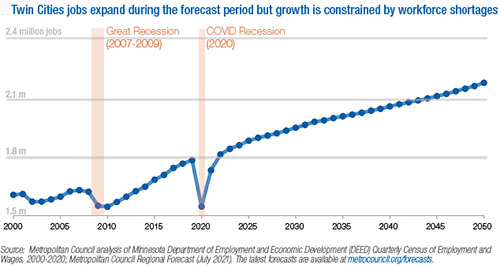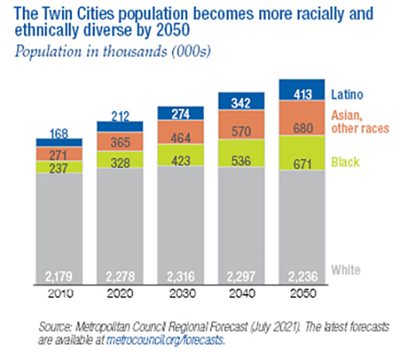 Despite the pandemic and 2020 recession, researchers at the Metropolitan Council expect the region’s population and employment will continue to grow at a steady and stable pace.
Despite the pandemic and 2020 recession, researchers at the Metropolitan Council expect the region’s population and employment will continue to grow at a steady and stable pace.
The Met Council develops forecasts of when, where, and how much population and job growth the region and its communities will experience. The 30-year regional forecast is updated every two years.
“We make predictions based on regional economic performance, demographic assumptions, and a range of factors,” said Council demographer Todd Graham. “Job losses in the spring of 2020 were widespread and serious, but also mostly temporary.”
Graham says the region’s economic base has shown resilience in the past year.
“We expect a reset in how major corporations, business site selectors, and investors evaluate the nation’s metro areas. In their comparison of metro areas, the Twin Cities metro area looks appealing. Our economic model analyzes the relationship between the regional and national economy and shows our long-term, 30-year outlook remains strong.”
Chair Charlie Zelle agrees the metro area is well positioned for future growth but cautions that regional prosperity cannot be taken for granted.
“The region offers economic opportunity, but it is not shared equally or equitably with Black, Indigenous, people of color, and people with disabilities,” Zelle said. “Workforce development and inclusion will be key to the success of our major industries and sustained prosperity.”

Forecast highlights and expectations
- We estimate the population of the seven-county region in 2020 was 3,183,000. This is slightly higher, 0.5%, than the Council’s previous forecast. The additional population came from domestic migration in recent years.
- The region’s forecasted population for 2040, 3,746,000, is 2.5% higher than the Council forecasted two years ago. The region’s population is expected to reach four million in 2050.
- The region will regain its lost economic activity in 2021 and employment levels will be restored by 2022. The employment level forecasted for 2040, 2,055,000 jobs, is 1.9% higher than was forecasted two years ago.
- The region’s forecasted population of 3,746,000 in 2040 will be 61% White and 39% Black, Indigenous, and people of color. Natural growth (more births than deaths), and international and domestic migration to the region are driving growing racial diversity.
- Birth rates have reached a historical low. Birth rate declines in the past decade were particularly steep for Latina and Asian women. Going forward, the Council projects birth rates will level off and stabilize.
- From 2020 to 2050, the population of people 75 years and older will more than double (145% growth), as baby boomers enjoy longer life expectancies than previous generations. The retirement-age population, 65-74 years old, will grow 44%. The under-65 population will grow only modestly; 15%.
- From 2021 to 2050, the region’s employment is forecasted to grow by 442,000 jobs. To meet the demand, working-age (those under age 65) U.S.-born workers will fill one-third of the net new jobs. Foreign-born workers will fill another one-third of the net new jobs. One-quarter of the workforce demand will be met by people delaying their retirement and increased senior participation. Additional jobs will be filled by people with multiple jobs and remote- and teleworkers living outside the seven-county region.
Regional Forecast Update
| Year |
2010 actual |
2020 forecast |
2021 forecast |
2030 forecast |
2040 forecast |
2050 forecast |
| Employment (BLS concept) |
1,548,000 |
1,549,000 |
1,733,000 |
1,947,000 |
2,055,000 |
2,175,000 |
| Share of US GDP |
1.16% |
1.19% |
1.19% |
1.21% |
1.24% |
1.28% |
| Population |
2,850,000 |
3,183,000 |
3,213,000 |
3,476,000 |
3,746,000 |
4,001,000 |
| Total population growth (10 years) |
207,000 |
333,000 |
30,000 |
294,000 |
269,000 |
255,000 |
- Natural growth (10 years)
|
233,000 |
198,000 |
16,000 |
188,000 |
155,000 |
127,000 |
- International migration (10 years)
|
66,000 |
93,000 |
NA |
95,000 |
107,000 |
111,000 |
- Domestic migration (10 years)
|
-92,000 |
42,000 |
NA |
10,000 |
8,000 |
16,000 |
| Black, Indigenous, People of Color (percent of regional population) |
24% |
28% |
29% |
33% |
39% |
44% |
Table shows Met Council’s latest population and employment forecasts. The population is forecast to grow to 4 million by 2050, up from 3.2 million today.
Forecast model
The Met Council uses the REMI-PI model, a product of Regional Economic Models, Inc., to update the regional forecast, consistent with a current national economic forecast and context.
We then rely on an additional land use forecast model to determine where future population and employment will go in specific areas within the region. The model considers how demographics, regional and local policies, amenities, and accessibility to destinations affect real estate supply and demand. This land use modeling will be prepared in 2022 and shared with local governments and the public.
Note: The U.S. Census Bureau is expected to release 2020 population results for counties, cities, census tracts, and all other geographics in August.
Long-range forecasts